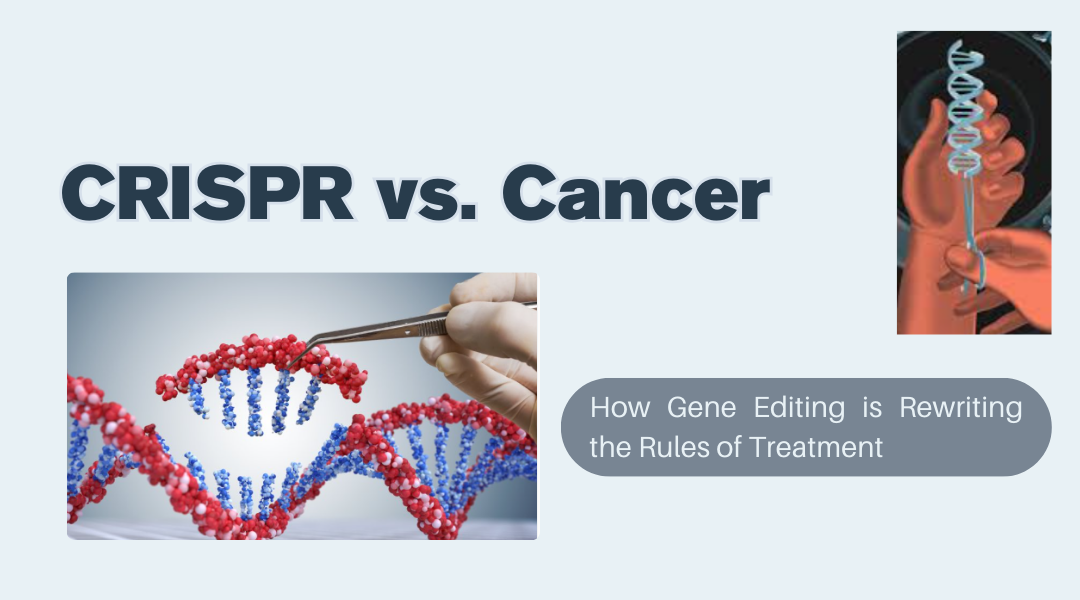Introduction: A Smarter Way to Fight Cancer
Cancer has always been a wily opponent—mutating, evolving, and outmaneuvering our best drugs. But what if we could reprogram the body to fight back with pinpoint accuracy? That’s exactly what CRISPR is making possible. Instead of carpet-bombing tumors with chemo, scientists are now hacking into cancer’s genetic code, turning its own weapons against it.
How CRISPR is Changing the Cancer Game
This isn’t about brute force. It’s about strategy:
- Shutting Down Cancer’s Command Center
- The Target: Oncogenes—the mutated genes that force cells to multiply like crazy.
- The Move: CRISPR snips these genes, cutting off the tumor’s growth signals. Early trials in glioblastoma (a deadly brain cancer) have slowed progression in patients who’d run out of options.
- Rebooting the Body’s Natural Defenses
- The Problem: Tumors often disable tumor suppressor genes (like p53), which normally stop runaway cell division.
- The Fix: CRISPR can reactivate these genes, like flipping a broken switch back on. In mice with aggressive breast cancer, this approach shrank tumors by 70%.
- Supercharging the Immune System
- The Breakthrough: Editing immune cells to hunt cancer better. Think of it like giving T-cells night-vision goggles to spot hidden tumors.
The CAR-T Revolution (Now with CRISPR Upgrades)
CAR-T therapy already reprogrammed immune cells to attack cancer—but CRISPR makes it even sharper:
- Fewer Side Effects: Early CAR-T treatments sometimes triggered deadly immune overreactions. CRISPR tweaks help avoid that.
- Stronger, Smarter Cells: Scientists are deleting genes like PD-1 (a “checkpoint” cancer exploits to hide) and adding new receptors to target multiple tumor types at once.
Real-World Wins (And a Few Cautionary Tales)
- A Leukemia Remission Miracle: In 2022, a 12-year-old with relapsed leukemia got CRISPR-edited CAR-T cells. Two weeks later, her cancer was undetectable—and still is.
- The First CRISPR Cancer Drug? The FDA is fast-tracking a therapy for multiple myeloma that combines CRISPR with CAR-T. Early data shows 80% response rates.
- When Editing Goes Wrong: A 2021 trial had to pause after a patient’s edited T-cells accidentally attacked her healthy liver tissue. Precision is improving, but mistakes still happen.
The Big Hurdles Ahead
- Cancer’s Shape-Shifting Tricks
- Tumors are genetic mosaics. Even if CRISPR kills 99% of cells, the 1% with different mutations can come roaring back.
- Delivery Headaches
- Getting CRISPR into the right cells (and only the right cells) is tough. Nanoparticles and viruses are in the works, but it’s like mailing a bomb defusal kit to one specific mailbox in a city.
- The Ethics of Editing
- Unlike fixing sickle cell in blood cells, editing immune cells could have unpredictable long-term effects. And what happens if engineered cells spread beyond the patient?
What’s Next?
- Combination Attacks: Pairing CRISPR with immunotherapy or targeted drugs to outflank resistant cancers.
- Precision Strikes: Using AI to predict which edits will work best for a patient’s unique tumor DNA.
- Prevention? One day, we might edit high-risk people’s cells before cancer appears—like a genetic vaccine.
The Bottom Line
CRISPR isn’t a magic bullet for cancer yet. But for the first time, we’re not just poisoning tumors or cutting them out—we’re rewriting the rules of the fight. The next decade will see cures we can’t even imagine today. And for patients out of options, that hope is everything.
